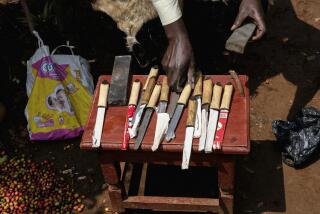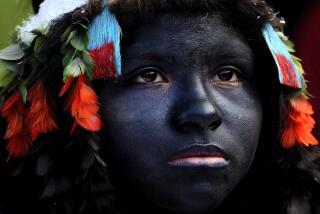Warrior Elite Battles to Keep Traditions : Cultures: A young nomad is the link between 20th-Century life and his village of thatched huts.
- Share via
LORRUBAE, Kenya — To the tourists staying at Buffalo Springs Lodge near here, the slender young man with the long braids and strings of beads draped on his ocher-painted body is a tribal dancer, one of several who perform at 2:30 every afternoon.
Joseph Bilaa Lekiluai is more than that. He is also a full-fledged moran , one of a long line of Samburu warriors who have fiercely defended their villages for centuries in the dry expanses of northern Kenya.
At 19, Lekiluai is a bridge between his pastoral, nomadic ancestors and an ever-encroaching modern society in this East African nation.
He speaks three languages fluently. He finished high school and traveled from Lorrubae, a village of thatched huts with cow-dung walls, to the high-rise capital, Nairobi, to be trained as a mechanic.
Unlike many of his friends, his earlobes are not pierced and distended, and the braided hair is a wig. Lekiluai wants to join the Kenyan army, not to carry on his warrior tradition but to use his mechanic’s training.
At the behest of his father, Lekiluai has taken a path different from his fellow warriors. Samburu village elders realize that today, young warriors find less and less to war against.
Yet Lekiluai manages a balance between the two worlds. His words echo his father, grandfather and great-grandfather: “If you’re not going to keep the culture, you’re not a Samburu.”
The independent-minded Samburu are resisting modernization. Although many of them are upgrading temporary villages into permanent settlements, so far they have resisted government efforts to divide and deed their land.
Lekiluai is one of the first young men in his village to have an education. Now most of the younger children attend school, at least through the third grade.
Seeing the erosion of values in some offspring who have gone away to boarding schools, some Samburu are building their own schools.
Preserving the culture includes circumcision rituals for both boys and girls. Every six or seven years, the elders initiate a group of boys and young men, usually ages 14 to 25, into manhood. The boys undergo three months of formal training. Then a circumcision ceremony marks their elevation to warrior status.
The new moran emerge from the ritual as village heroes. Armed always with razor-sharp spears and clubs, they paint themselves with ocher, adorn themselves with beadwork made by the women and braid their hair elaborately.
The privileged young warriors, confident as professional athletes, strut through their villages and gaze without blinking at the small world that is finally theirs.
Yet they are obedient to the elders. “If you don’t do what the elders say, you’re going to be cursed”--or at least beaten, Lekiluai said.
The warriors the elders pick to be guards live in four huts built for them by their mothers around the edge of the village. Women do most of the physical work in Samburu villages, including construction.
Drought brings a dance to Lorrubae that the tourists won’t see. It has been so dry around the village that no grass has grown, and the cattle must graze miles away.
The elders sacrificed a goat seven days ago and designated the junior elders, including Lekiluai’s older brother, to dance one night to induce rain.
The men jump high into the air, stamping their feet as they land. The women join in, holding their husbands’ hands and undulating to the rhythm.
Late that night, as the singing of deep voices vibrates through the darkness, the rains come.
In a few years, after he has married and become a junior elder, Lekiluai will be one of the dancers.
He will assume the greater responsibilities earlier than his father did. Today’s swiftly changing times require young Samburu men to be brought sooner into the group of elders to help make decisions about events pressing from the outside that will continue to radically alter their way of life.
Skirmishes with cattle rustlers now occur only at villages far to the north. Lion attacks are few. But many Samburu traditions still are passed from one generation to the next.
“As our forefathers said, ‘Don’t lose the culture,’ ” Lekiluai said. “It’s better to be dead than to leave the culture.”
More to Read
Sign up for Essential California
The most important California stories and recommendations in your inbox every morning.
You may occasionally receive promotional content from the Los Angeles Times.













